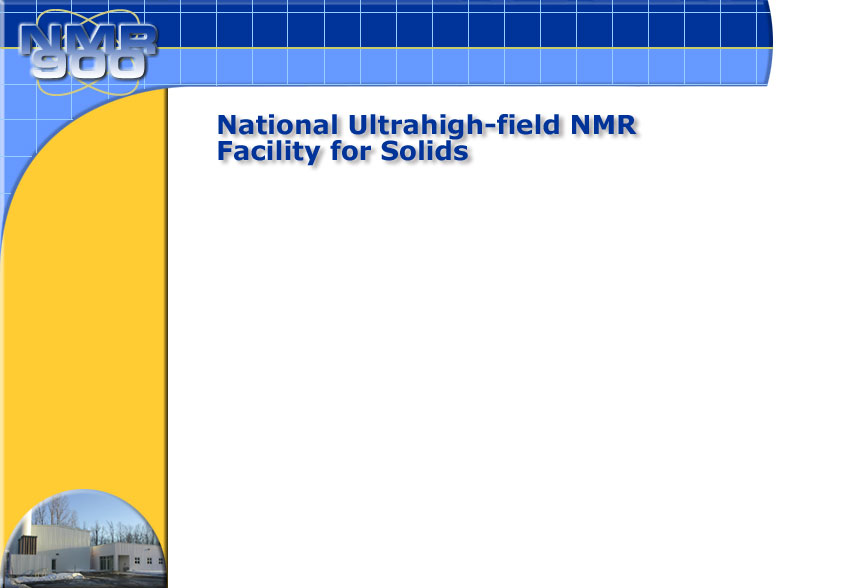
|
Spectra
|
|||
Solid-state
NMR spectra @ 21.1 Tesla
(Click on spectrum to enlarge)
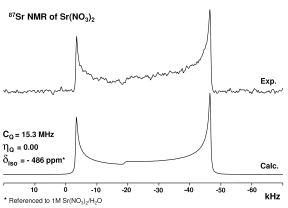
Another example when NMR experiments with low-gamma low-sensitivity quadrupolar
nuclei, here Sr-87, performed at 21 T in a straightforward simple manner.
Done by V. Terskikh (the 900 Facility) with a home-built 5 mm solenoid probe.
January, 2007
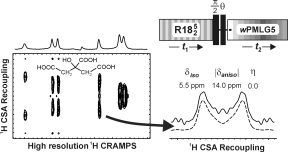
1H CSA recoupled spectra of citric acid. Experiments performed by Darren Brouwer
(SIMS NRC) with the 2.5 mm MAS probe. ASAP
in JMR.
December,
2006
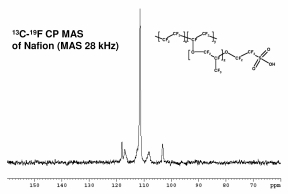
13C-19F CP MAS spectrum recorded for a hydrated Nafion film. In such high-resolution
spectra various C-F species can readily be identified. Experiments performed
by Shane Pawsey (the 900 Facility) with the 2.5 mm MAS probe.
October, 2006
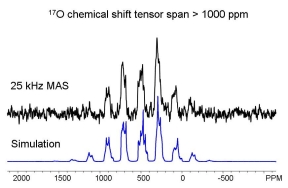
High-speed MAS 17O NMR spectrum for 4-nitrobenzaldehyde. Experiments performed
by Gang Wu (Queen's University) with the 2.5 mm MAS probe (unpublished results).
August, 2006
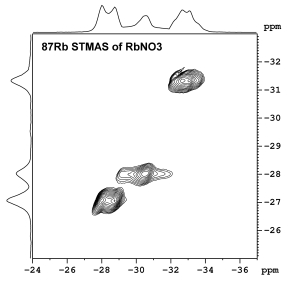
Similar to MQMAS, satellite transition MAS of half-integer quadrupole nuclei
(STMAS) can be used to separate anisotropic from isotropic interactions. Experiments
performed by S. Steuernagel (Bruker) with the 2.5 mm MAS probe.
July,
2006
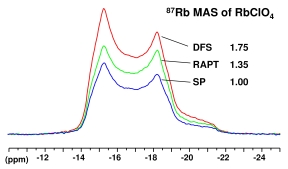 Sensitivity
enhancement in MAS spectra of half-integer quadrupole nuclei, DFS (double
frequency sweep), RAPT (rotor assisted population transfer), compared with
a SP (single pulse) experiment. Performed by S. Steuernagel (Bruker) with
the 2.5 mm MAS probe.
Sensitivity
enhancement in MAS spectra of half-integer quadrupole nuclei, DFS (double
frequency sweep), RAPT (rotor assisted population transfer), compared with
a SP (single pulse) experiment. Performed by S. Steuernagel (Bruker) with
the 2.5 mm MAS probe.
July,
2006
 127I
NMR of NaIO4 revisited at 21.1 T. Cq=42.3 MHz, CSA is negligible (the span
is <20 ppm). For more see: G.
Wu and S. Dong, SSNMR 20 (2001) 100-107
127I
NMR of NaIO4 revisited at 21.1 T. Cq=42.3 MHz, CSA is negligible (the span
is <20 ppm). For more see: G.
Wu and S. Dong, SSNMR 20 (2001) 100-107
March,
2006
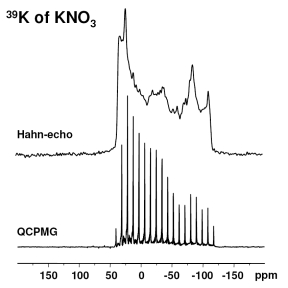 In
materials ultrahigh magnetic fields are beneficial when studying low-gamma
(and) quadrupolar nuclei. These 39K NMR spectra of KNO3 were recorded on our
900 instrument at the resonance frequency of 42 MHz (compare with 23 MHz at
11.7 T). Experiments performed by I. Moudrakovski (SIMS-NRC) with the wideline
static probe built by J. Bennett (NRC).
(don't mind S/N in the Hahn-echo spectrum, only few scans were accumulated
!)
In
materials ultrahigh magnetic fields are beneficial when studying low-gamma
(and) quadrupolar nuclei. These 39K NMR spectra of KNO3 were recorded on our
900 instrument at the resonance frequency of 42 MHz (compare with 23 MHz at
11.7 T). Experiments performed by I. Moudrakovski (SIMS-NRC) with the wideline
static probe built by J. Bennett (NRC).
(don't mind S/N in the Hahn-echo spectrum, only few scans were accumulated
!)
February,
2006
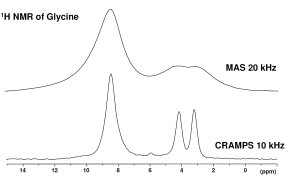 The
resolution in proton spectra of solids is improved by applying combined rotation
and multiple-pulse spectroscopy (CRAMPS). Experiments performed by M. Monette
(Bruker) with the 2.5 mm MAS probe.
The
resolution in proton spectra of solids is improved by applying combined rotation
and multiple-pulse spectroscopy (CRAMPS). Experiments performed by M. Monette
(Bruker) with the 2.5 mm MAS probe.
January,
2006
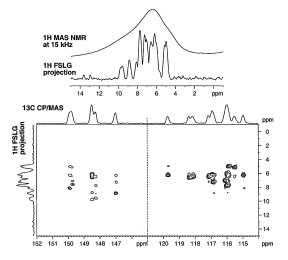 1H/13C
HETCOR with Frequency-Switched Lee-Goldberg (FSLG) 1H homonuclear decoupling
for alpha-Hydroquinone. Experiments performed by D. Brouwer (NRC-SIMS) with
the 3.2 mm MAS probe.
1H/13C
HETCOR with Frequency-Switched Lee-Goldberg (FSLG) 1H homonuclear decoupling
for alpha-Hydroquinone. Experiments performed by D. Brouwer (NRC-SIMS) with
the 3.2 mm MAS probe.
December,
2005
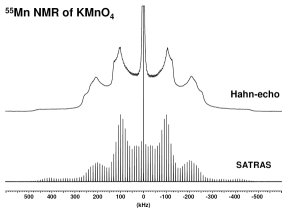 Both
experiments were performed with the 3.2 mm MAS probe. With very short rf-pulses
available on the 900 very broad static lineshapes can be correclty recorded.
In
this case a solid-state 90-pulse for 55Mn was 0.6 us.
Both
experiments were performed with the 3.2 mm MAS probe. With very short rf-pulses
available on the 900 very broad static lineshapes can be correclty recorded.
In
this case a solid-state 90-pulse for 55Mn was 0.6 us.
November,
2005
 Quadrupolar
Carr-Purcell Meiboom-Gill (QCPMG) pulse sequence dramatically improves signal-to-noise
in solid-state NMR experiments of quadrupolar nuclei, here for 87Rb (I=3/2).
Quadrupolar
Carr-Purcell Meiboom-Gill (QCPMG) pulse sequence dramatically improves signal-to-noise
in solid-state NMR experiments of quadrupolar nuclei, here for 87Rb (I=3/2).
October,
2005
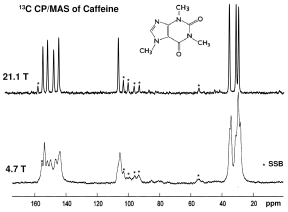 13C
CP/MAS spectrum of caffeine. At 21.1 T note absence of the line splitting
due to the dipolar coupling with the quadrupolar 14N. At lower magnetic fields
such coupling results in very complicated spectra.
13C
CP/MAS spectrum of caffeine. At 21.1 T note absence of the line splitting
due to the dipolar coupling with the quadrupolar 14N. At lower magnetic fields
such coupling results in very complicated spectra.
September, 2005
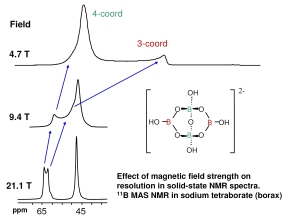 11B MAS NMR spectra of sodium tetraborate (borax). Even at 14.1 T two
non-equivalent boron sites would partially overlap complicating interpretation
and quantitative analysis of the spectra.
11B MAS NMR spectra of sodium tetraborate (borax). Even at 14.1 T two
non-equivalent boron sites would partially overlap complicating interpretation
and quantitative analysis of the spectra.
September,
2005
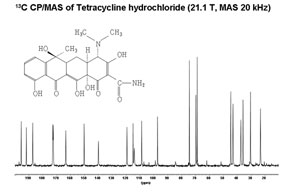 13C
CP/MAS spectrum of tetracycline hydrochloride. Resonances from all 22 carbon
atoms are resolved.
13C
CP/MAS spectrum of tetracycline hydrochloride. Resonances from all 22 carbon
atoms are resolved.
September, 2005